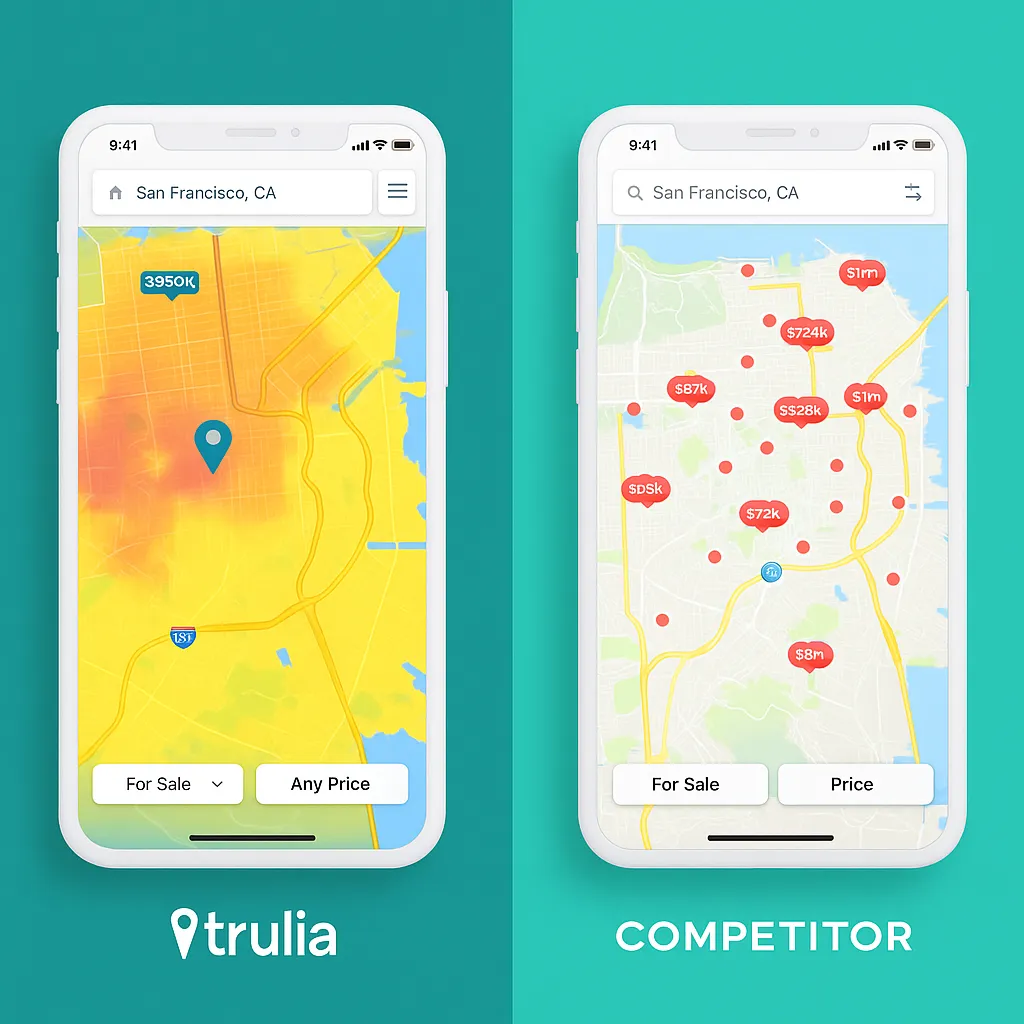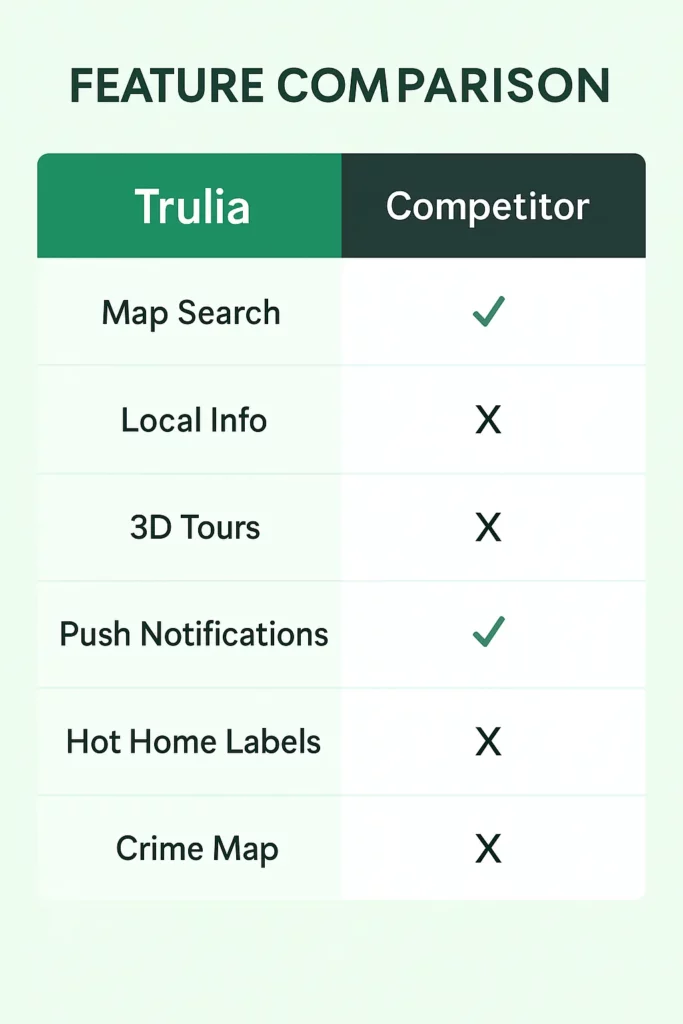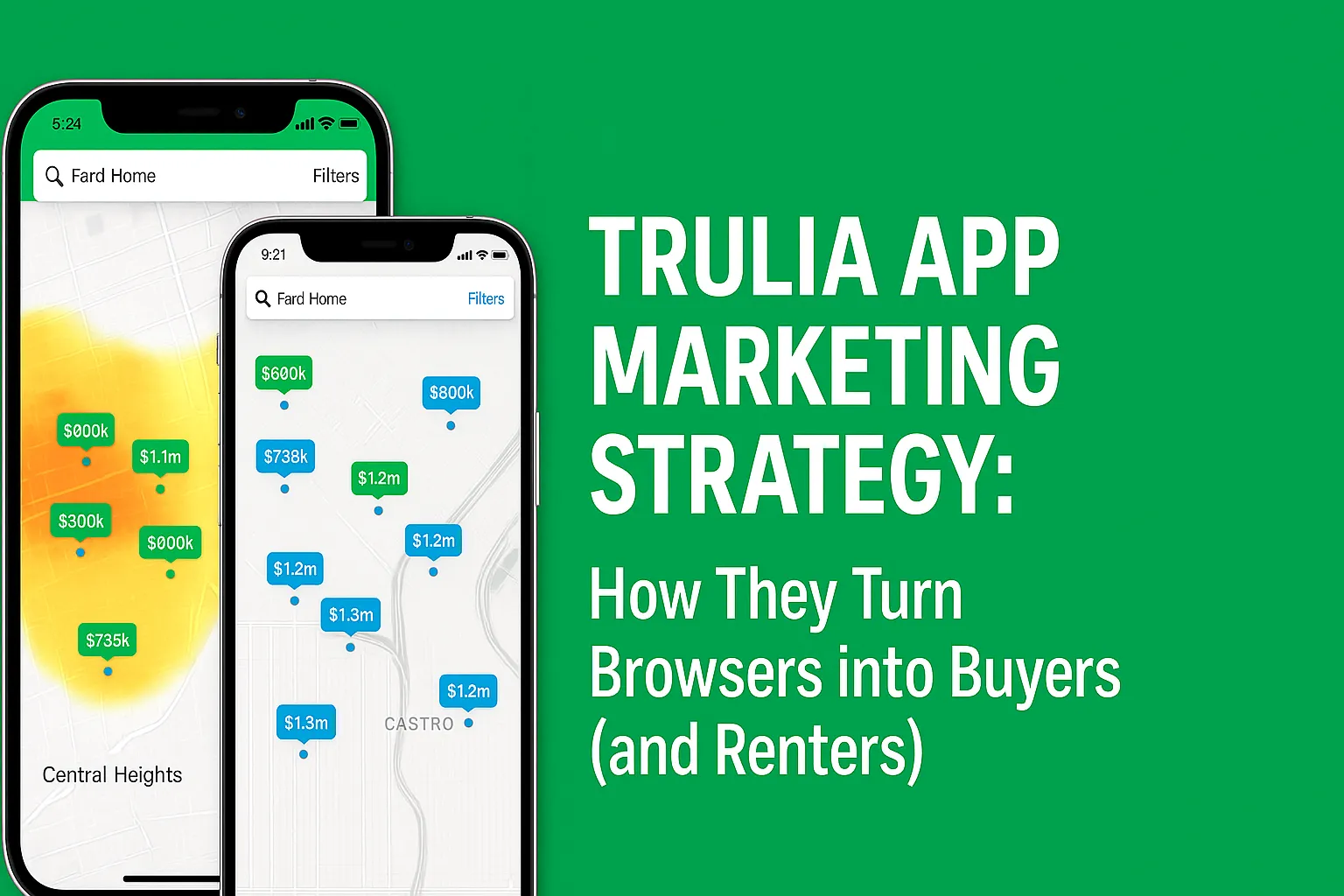If you’ve ever found yourself scrolling endlessly through dream homes you can’t quite afford (guilty!), you’ve probably bumped into Trulia. It’s not just a real estate app — it’s a wish list in your pocket. From dream homes to deal-hunting apartments, Trulia’s app makes real estate search feel like window-shopping for your future.
But Trulia isn’t just winning hearts — it’s winning market share. In a space jam-packed with giants like Zillow, Redfin, and Realtor.com, Trulia carved out a strong identity with sleek UX, hyperlocal insights, and content that actually helps people make decisions (not just daydream). They’re proof that in the digital property game, strategy sells.
If you’re thinking of building a real estate like trulia app that stands out — whether for buyers, renters, or agents — you’ll want to learn from Trulia’s marketing playbook. Let’s break it down — and show how Miracuves can help you build your own Trulia-style app, ready for growth from day one.’

Positioning That Hits Home (Literally)
Speak to the Dream and the Data
While Zillow leaned into pricing tools and MLS integration, Trulia spoke directly to lifestyle: school districts, crime stats, walkability, dog parks — you name it. Their messaging wasn’t about property listings — it was about belonging.
- “Find a home where you’ll love your life” wasn’t just a tagline — it was strategy.
- They built community-based trust: neighborhood reviews, locals’ insights, and safety maps.
Trulia made their app not just a search engine but a decision-making tool — one that “felt human” in a space dominated by stats and numbers.
SEO + Content Marketing = Long-Term Growth
Trulia didn’t go all-in on PPC. They played the long game with content and organic SEO, targeting every imaginable question a buyer or renter might Google.
- “Best cities for remote workers”
- “Affordable neighborhoods in Austin”
- “Should I rent or buy in 2025?”
Every answer came with neighborhood overviews, interactive maps, and naturally embedded CTA links to listings.
CB Insights – Real Estate Tech Growth Trends 2024
App Store Optimization (ASO) That Hits All the Right Filters
Trulia ranks highly on both Android and iOS for a reason:
- Keyword-rich titles like “Real Estate & Homes for Sale”
- Localized listings: “Homes in Denver,” “Brooklyn apartments under $2k”
- Ratings prompts and real reviews built into the app experience
They understood that search inside the app store is just as important as Google — and optimized for both.
Visual Search + Emotional Design = Instant Hook
Trulia was one of the earliest platforms to double down on aesthetics in real estate UX.
- Eye-catching visuals
- Big, swipeable photos
- “Save to collection” boards (think Pinterest meets Zillow)
This approach made people browse longer — and helped build emotional connection.
Push Notifications That Actually Work
Trulia uses triggered notifications based on user behavior:
- New listings in saved searches
- Price drops on saved properties
- “New homes just listed in your dream zip!”
The notifications aren’t spammy — they’re helpful and emotionally timed. It’s less “here’s an alert” and more “don’t miss your future home.”
Hyperlocal Targeting & Neighborhood Authority Features
Here’s where Trulia got smart: they positioned themselves as the neighborhood expert.
- Crime heat maps
- School district ratings
- Commute visualizations
Learn More: Top Trulia Features Every Real Estate App Needs
Their data integrations weren’t flashy — they were practical, helping users feel informed. For any startup building a Trulia-style app, this is gold.
How to Build Your Own Real Estate App with Miracuves
Paid Media Strategy: Context Over Clickbait
Trulia’s ad strategy is highly focused:
- Google search + display retargeting
- Pinterest ads for dream-home planners
- YouTube pre-rolls with “What’s it like living in…” content
- Partnered with lifestyle bloggers for local home tours
They don’t shout. They guide users into the app, gently nudging based on browsing habits.

Trulia vs The Competition: What Sets It Apart
| Feature | Trulia | Zillow | Redfin |
|---|---|---|---|
| Emotional design focus | ✅ | ❌ | ❌ |
| Neighborhood heatmaps | ✅ | Partial | ❌ |
| Lifestyle-based search | ✅ | ❌ | ❌ |
| Strong blog + organic strategy | ✅ | ✅ | ❌ |
| User review integrations | ✅ | ✅ | ✅ |
Conclusion
Trulia isn’t just a real estate app — it’s a lifestyle matchmaker. Their marketing strategy speaks to emotion, usability, and trust — all while staying SEO-savvy and visually polished.
At Miracuves, we help innovators launch high-performance app clones that are fast, scalable, and monetization-ready. Ready to turn your idea into reality? Let’s build together.
FAQs
What makes Trulia’s strategy so effective?
Trulia combines local insights, emotional storytelling, and smart search optimization to build deep engagement.
How does Trulia drive organic growth?
They leverage SEO-driven blogs, neighborhood landing pages, and Google-indexed listing pages.
Does Trulia run paid ads?
Yes — but with precise targeting. Their campaigns are lifestyle-driven and platform-specific (Pinterest, YouTube, etc.)
Can a startup realistically compete with Trulia?
Absolutely. By focusing on a niche (like rentals, student housing, or smart home listings) and offering better UX, you can carve a profitable path. Miracuves can help.
What technology powers Trulia?
They use mapping APIs, real estate MLS feeds, user data analytics, and mobile-first UI architecture — all of which Miracuves supports in its app builds.
Is it possible to build a Trulia-style app without a huge team?
Yes. With Miracuves’ real estate app clone solutions, you can get a powerful MVP to market faster, with less overhead.








